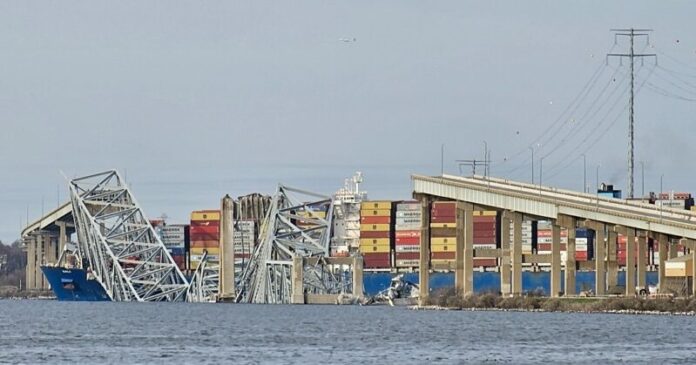- The collapse of the Francis Scott Key Bridge in Baltimore has caused serious disruption of local traffic as well as global shipping
- The collapse blocked main access to the port and trapped two navy vessels, six bulk carriers, and the loss of at least six lives
- The Port of Baltimore handles 109,000 20-foot equivalent units of container freight monthly
- It is one of the largest handlers of cars and trucks in the US
The collapse of the Francis Scott Key Bridge in Baltimore has caused serious disruption of local traffic as well as global shipping, an analysis produced by S&P Global Market Intelligence said after the incident.
The Port of Baltimore handles 109,000 20-foot equivalent units of container freight monthly.
Last March 26, the bridge collapsed after being hit by Dali, a containership operated by Maersk on an international route between Asia and the US East Coast.
The collapse of the bridge resulted in blocking of the main access to the port and trapped two navy vessels, six bulk carriers, and the loss of at least six lives.
“The bridge collapse is the latest challenge for northeast US supply chains,” said Chris Rogers, head of supply chain research, S&P Global Market Intelligence.
The challenges include access to the Red Sea and the Panama Canal, as well as the possibility of port strikes in the middle of this year.
Rogers also said the reconstruction of the bridge and cargo delays are likely to be “extensive.” To lessen the delays, some freight across containerized and bulk modes could be rerouted to nearby ports in Delaware and Pennsylvania.
“The port handled around three percent of all US east and gulf coast imports and 10 percent of US northeast imports of containerized freight in the 12 months to Jan. 31, 2024,” said Rogers, adding that “it is particularly important for the wood, construction machinery, and steel/aluminum sectors.”
Consumer goods exposures include home appliances and furniture, he also said.
The Port of Baltimore is also one of the largest handlers of cars and trucks in the US, though one of the major terminals is located some distance from the bridge, possibly facing less disruption.
The port handled 650,897 TEUs of inbound traffic and 272,859 TEUs of outbound shipments in the 12 months to Jan 31 this year. These accounted for 2.8% and 3.1% of the US East Coast and Gulf Coast total, respectively, said S&P Global Market Intelligence data.
Container freight accounted for 75% of volumes handled through the port in the last 12 months, with cars and roll-on, roll-off capacity representing another 18%. Bulk shipments of steel and forestry products accounted for most of the remainder.
Photo on this page from the Baltimore County Fire Department.
READ: Port of Baltimore closure could disrupt US East Coast economy





